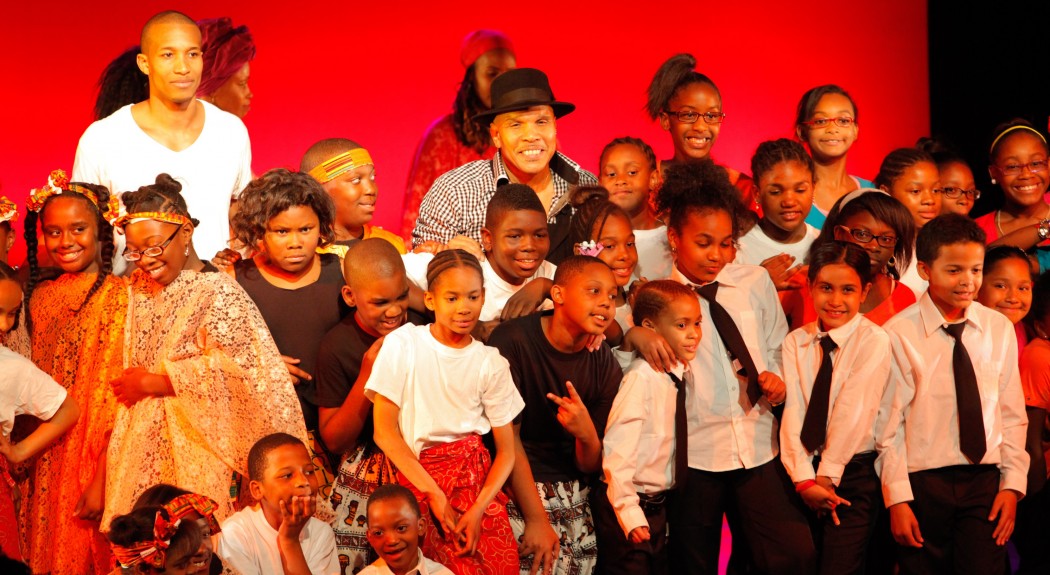“The scouts quieted down for this one although it was filled with exactly the kind of exaggerated bits the girls honked at before. Because the movement was made to serve the art, these exuberant kids were carried beyond the tricks to something better before they knew what had happened to them.”
Sally Sommer, The Village Voice
Programs
Harlem Children’s Zone in association with The Forces of Nature present the Youth Academy of Dance & Wellness
The mission of the Youth Academy of Dance & Wellness is to train young people in the arts and discipline of dance, stimulate wellness physically and mentally, as well as encourage a sense of wonder for the endless possibilities that exist within them. The scholarship program will provide the supportive environment for young dancers and musicians ages 12 to 17 to explore their strengths, dreams and creative talents through FREE classes offered in Ballet, Modern, Hip Hop, African Dance and repertoire.
Our Educational Mission
Continue Reading →
Outreach and Performance Programs
Concerts
The concert presentation is chosen from the company’s repertoire of over 50 works. Full company or chamber company. 120 minutes including a 15‑minute intermission.
Mini‑Concerts
Works are chosen from the main stage repertory, which can be performed with minimal lighting and suited to the technical limitations of the facility. Full company, chamber company, duets, and solos. 60 minutes with no intermission.
Lecture Demonstrations
Works are chosen from the educational program repertoire in addition to solo, duet and chamber works suited to the technical limitations of the facility. 5‑9 artists, including dancers and musicians. 30‑60 minutes.
Master Classes
Classes are offered in West African, Modem dance, Ballet, Afro-House, and Fusion. Musical instruction for percussion instruments is also offered by the company. The levels of instruction range from beginning to advanced, and are available for senior citizens, physically challenged, and special needs populations. 2‑4 artists. 60‑120 minutes.
Residency Options
Programs featuring choreography, collaborative work, teacher training (curriculum development) for public schools, colleges, universities, civic and private organizations can be scheduled (no more than 3 activities per day). Full company, chamber company, education unit (2‑8 artists). 2‑21 days
Teacher Training
Through lectures, demonstrations, dance, songs, and stories, teachers are given “movement language”, information, and materials to be used in their classrooms to teach African and Native American (No., Central, So. American) history and culture. Teachers are provided with study guides, basic movement vocabulary, a bibliography of current titles, and instruction on how to create a resource center for their classroom. 2 artist/instructors.
Educational Programs
Ancestral Earths
This program is designed to introduce participants to the historical and cultural bridges between Native Americans, African Americans, and Latino Americans. The program includes singing, dancing, drumming, folktales, and historical symposia examining the cultural bonds between these three distinct groups of people. Study guides and videotapes are available for teachers and students upon request.
Maatye’s Journey
Maatye’s Journey transports urban youth from the streets of the city to the world of self‑knowledge by imaginatively transporting them through the African Diaspora. Each participant travels to Africa and the Caribbean Islands, and back to the Americas through music, dance and storytelling. At each point of the Journey”, the students encounter a unique cultural experience. Step by step, these experiences educate and expose the students to the all‑encompassing presence of African culture in each place that they visit. Ultimately, this Journey” leads the student to a newly‑acquired knowledge of a shared linkage to a common heritage and African ancestry.
Primal Imagery
This program focuses on the use of animal imagery as symbols of power and how these images have taught men and women about survival, balance, and society since the beginning of time. The program consists of dances, music, songs, and visual art from Nigeria, Senegal, Haiti, Mexico, and Puerto Rico. Study guides and a video presentation are available.
Rhythms of Mali
This program introduces audiences to the cultural riches of the ancient Mali empire. Through music, dance, and accompanying narration, students learn about the history, traditions, and belief systems of the powerful empire that subsequently evolved into the nations of Senegal, Guinea, the Ivory Coast, and Mali. Lecture‑demonstrations and concerts include a “Bantaba” or “dancing circle” where the audience is invited to join the company in a traditional African dance experience. Study guides and video presentations are available.
Kwanzaa
Forces of Nature holds the distinction of producing the largest Kwanzaa celebration in New York City each year. Special activities for children, elders, and the family are central to the event, which attracts a multi‑ethnic audience from all over the country. In order to educate and enlighten the general public, educators and community leaders about this empowering cultural and spiritual holiday that is celebrated by over 13 million people world wide, the company conducts educational Kwanzaa lecture‑demonstrations, workshops, mini‑concerts, and performances designed to expose everyone to the basic principles of this cultural and spiritual holiday celebrated by millions of people around the world.
Living Images
“Living Images” are a series of short dramatic presentations, which expose teachers, students and community members to new models of cultural and racial interaction. “Living Images” examines racism, stereotyping, values conflicts, and prejudice, in a non‑threatening and objective manner. Students, teachers, and community members are encouraged to discuss the issues as “observers” rather than “participants”. The goal is to produce an open sharing of feelings, reflections, experiences, and general perceptions without fear of judgment.

